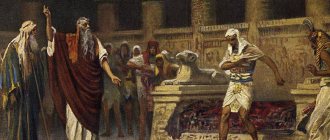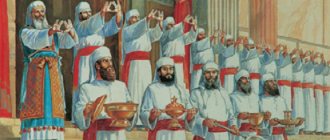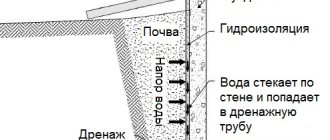March 13, 2017Anthropology, History
Ritual cries, barley groats, gilded horns and other important details of one sacrifice ceremony
Author Alena Chepel
The word "sacrifice" refers to different ancient Greek rites performed in different circumstances and for different purposes. This includes offering fruits, grains and cakes to the gods, and burning incense, and killing animals and then eating the remaining meat, and burning whole animals, and the ritual libation of wine, milk, honey, water or oil, and the shedding of sacrificial blood to seal the oath.
The most common type of sacrifice among the ancient Greeks, the slaughter of livestock, was called thysia. The meat was partially burned: the gods got the smoke, and the ceremony participants got the meat.
The philosopher Theophrastus identified three purposes for sacrifice: to honor the gods, to thank them, and to ask them for something. But this is only one of the possible interpretations of the ritual. Already in the 20th century, the Hellenist and specialist in ancient Greek religion Walter Burkert put forward a new version: the meaning of sacrifice is the feeling of guilt that you experience after murder. The ritual neutralizes the outburst of aggression associated with killing an animal. However, this theory was refuted as contradicting ancient evidence. Some historians believe that the purpose of the sacrifice is to establish a social hierarchy between the participants in the ritual, including the gods, through the distribution of the best and worst pieces of meat during a joint meal. Thus, sacrifice, as it were, consolidates and justifies socio-economic and political reality. From an anthropological point of view, sacrifice is analogous to a gift: people present a sacred gift to the gods, counting on gifts in return. Such gifts form the basis of relationships both between people and with otherworldly forces.
The Greeks did not have a separate class of priests, so anyone could perform the sacrifice. A butcher was often called in to cut the meat. The sacrifice was performed not inside the temple, but next to it, at the altar in the open air. Chamber home sacrifices were often held with the family. If lunch or dinner was planned after the ritual, the ritual feast was held in special rooms at the sanctuary or at home. Sometimes sacrificial meat was sold, but still most bones of domestic animals are found in sanctuaries. It turns out that the Greeks almost always ate meat after the ritual slaughter of an animal - that is, quite often, judging by the surviving calendars with instructions on when and to which gods to make sacrifices. A large number of livestock were slaughtered on the occasion of annual city holidays. During private ceremonies, as a rule, one small animal was used.
1 / 2
Stele with a calendar of holidays and sacrifices from the city of Thorikos. 430–420 BC e. Remi Mathis / CC BY-SA 3.0
2 / 2
Fragment of a stele with a calendar of holidays and sacrifices from the city of Thorikos. 430–420 BC e. Dave & Margie Hill / CC BY-SA 2.0
The rules of the ceremony were not compiled into a rigid system: the sequence of actions varied in different policies. We know about different types, methods and procedures of sacrifice from special ritual texts that had the status of laws and were carved in stone for public viewing. Other sources include ancient literature, vase painting, reliefs, and, more recently, zooarchaeology (analysis of the remains of animals sacrificed). This evidence allows us to understand some of the patterns of thysia and reconstruct the features of the ritual.
Choose a victim
Bull sacrifice. Crater painting. Attica, 410–400 BC. e. A crater is a vessel for mixing water and wine.The Metropolitan Museum of Art
First, you need to determine the budget for the sacrifice. The most expensive animal is a cow. If a big holiday is coming up (for example, the patron goddess of the city), it makes sense to spend money, for example, on 50 cows. But piglets are a cheap option that is used in the purification ritual: the participants in the ritual are sprinkled with the animal’s blood, but the meat itself is not eaten. The most common sacrificial animal is the sheep: ideal value for money. The choice of animal also depends on who the sacrifice is intended for. Everything is important here - the animal’s age, gender and color. Males are suitable for gods, and females are suitable for goddesses. Black animals are sacrificed to the underground chthonic gods. Before starting the ritual, check with special calendars and other ritual texts: for example, on the 12th day of the month of Anthesterion (which falls in our February - March), the god of wine Dionysus needs to sacrifice a dark red or black kid with unerupted teeth, and the goddess of fertility Demeter in the month of Munichion (April - May) - a pregnant sheep. The goddess of night witchcraft, Hecate, will have to sacrifice a dog, but this is a different type of sacrifice: the Greeks did not eat dog meat.
Important advice: Do not sacrifice people, even if you read about it in ancient Greek myths and literature. Human sacrifice is not attested in Greece.
Find a professional musician
Scene of sacrifice. A young man (left) plays the aulos. Crater painting. Attica, around 430–410 BC. e. © The Trustees of the British Museum
Each stage of the ritual should be accompanied by music. Good performance pleases the gods and disposes them to the ritual. Special ritual hymns are called prosody and paean. The first should be sung while the animal is being led to the altar (the music sets the rhythm of the procession), the second should be sung already at the altar itself. Singing occurs to the accompaniment of the pipe - avla. While the aulet plays, the procession waits for auspicious signs to begin the ceremony. The logic of the gods, however, is not always clear. Thus, Plutarch tells a story about the musician Ismenias, who played the flute for a long time, but there were still no signs. Then the impatient customer of the sacrifice took the flute from the professional and clumsily played it himself, and only then did the sacrifice take place. To which Ismenius replied that the gods liked his music, so they were in no hurry to make a decision, but, having heard the amateur’s music and deciding to get rid of it as quickly as possible, they nevertheless accepted the sacrifice.
Important tip: Avlet will have to pay, but you can do this by sharing the sacrificial meat with him.
Why make sacrifices and why not on private altars?
Put on hold Put on hold Subscribe You are subscribed Oh, these sacrifices! No matter how much you explain and spread theories, it is still difficult for a modern person to accept them and see anything positive in the killing of animals. Yes, we kill them for food, but there’s no other way, how else can we eat them? But for the sake of offering to G-d - why is this necessary? Is there no other way to serve Him?
Yes, and He himself said that it is possible: according to the sages, after the destruction of the Temple, prayers help instead of sacrifices. The morning prayer of Shacharit corresponds to the morning sacrifice of Tamid, the prayer of Mincha corresponds to the afternoon sacrifice, etc. That’s good, why not leave - and initially arrange - everything exactly like that?
We can think and try to formulate a lot, but I wouldn’t be surprised if we end up having to say: in our current state, we are not able to truly understand sacrifices. We have long lost the habit of them as a means of getting closer to G‑d, so any rational argument or quote will encounter internal protest. We simply do not understand many aspects of the world in its original state and the commandments related to them.
But perhaps we can to some extent “grasp” an understanding of exactly how prayers replace sacrifices. This replacement, it turns out, is not so simple.
Private offerings: not possible or possible?
But first, one more question: if sacrifice is a good thing, then why not everywhere? In this chapter (Vayikra 17) the Torah strictly prohibits offering them on a private altar (bama), outside the Temple. The punishment for this is the extermination of the soul (karet), one of the most severe in the Torah, as for violating Shabbat or for debauchery. Although we are talking about making sacrifices to G-d Himself, and not to idols. Why is such an offering considered such a grave sin?
And if it does, then why not always?
Indeed, in this regard, there were different periods in Jewish history. After the Jews settled in the Land of Israel, offerings on private altars were permitted as long as the Tabernacle remained in the city of Gilgal. After its removal to Shiloh, private altars were prohibited, but after the destruction of Shiloh (at the end of the era of the Judges and the beginning of the era of the Prophets) they were allowed again - until the construction of the Temple. Thus, there were times when offerings could be made on private altars. This means that back then it was considered a noble deed, serving G‑d. And there were times when, on the contrary, it was impossible to make such offerings, and this was considered a terrible sin. Is this good or bad, and if bad, why?
There are hints in the Torah that such offerings are associated with idolatry. For example, explaining the prohibition in this chapter, the Torah says: “So that the children of Israel may deliver their sacrifices, which they slaughter in the field, to the Lord, in the Tent of Meeting... and so that they no longer slaughter their sacrifices to demons,” that is, to idols (ibid. 17:5-7). What if they make sacrifices in the field, but to God? All the same, according to the Talmud (Sanhedrin 106b, Rashi there), sacrifice outside the walls of the Temple is like offering to idols. Also, according to the Talmud (Menachot 109a), a kohen (priest) who made an offering outside the Temple becomes unfit for further service, like a kohen who made an offering to idols. But why, if in fact people brought it to G‑d?
Undermining unity is the root of idolatry
The answer is given by commentators: unity is required in sacrifice, for this is how the Unity of G‑d is reflected: everything is offered to one G‑d in one place. If different people bring in different places, it seems that everyone brings to their own god (Abarbanel, Vayikra, ibid.).
After all, the key difference between serving G‑d and serving idols is not simply that one is “right” and the other is not, but that there are many idols, but G‑d is one. “Idols” are not necessarily fictitious gods or carved images: they can be real forces of nature, “stars”, angels - but each of them represents one of many forces, while G-d rises above all and is the source of them all; they are just puppets in His hands. Idolatry is the loss of understanding of this fact, the loss of connection with the one G-d and the worship of individual forces that are not independent in reality. And serving G‑d is a connection with the Source itself, in which everything is one. This is the meaning of Judaism, therefore Jewish service to G-d must be performed by everyone together.
Malbim (at the beginning of Chapter Truma) adds: when everyone makes sacrifices in one place, this also testifies to the unity of the people themselves, which is also connected with the essence of Jewry. Only by achieving complete unity (“as one man, with one heart”) were the Jews worthy of receiving the Torah (Rashi Shemot 19:2). When they slipped as a result of the sin of the golden calf, then, in addition to idolatry, the unity of the people was also broken.
For here, too, one thing is connected with the other: the worship of the One G-d creates unity among the people, a common goal unites, and the worship of idols creates a split, for there are many idols, and the worshipers of each deny the others. So when the Jews worshiped the calf, it is said (Shemot 32:4): “These are your gods, O Israel,” in the plural. The Sages (Sanhedrin 63a) interpret: although the Torah mentions one calf, in fact there were many deities.
Thus, although offerings on private altars were made to G-d, they were associated with idolatry and were therefore also strictly prohibited.
But then another question remains and even intensifies: why were there eras when offerings on private altars were allowed? Where did the association with idolatry go then?
And why should people be tempted to make offerings on private altars, so that the Torah either allows them or with great effort restrains them? Judging by the texts of the Tanakh, offerings on private altars in the era of the Tanakh were indeed extremely common, people were clearly drawn to it. But what difference did it make to them where to sacrifice the animal, on a private altar or in the Temple? Well, maybe it’s more difficult to get to the Temple - and in that era, transport was not very good, to put it mildly - but it still doesn’t seem like that was the only factor. People not only wanted to avoid hassle, but were literally eager to sacrifice on private altars. Why?
Own way
I heard this explanation. Sacrifice is one of the ways to serve G-d. Today it is difficult for us to understand the essence of the sacrifice itself, but it can be understood by the example of other ways of serving G-d that are available to us: prayer and Torah study. After all, as has been said, in our time prayer to a certain extent replaces the sacrifices themselves, as well as the study of their laws in the Torah.
And in prayer and in the study of the Torah, the following is observed: although the Torah is one, and the text of the prayer in our time is also the same for everyone, nevertheless, each person has his own approach to studying the Torah and his own style of prayer. And so does every group. There are different types of Jews: in our time - Ashkenazim, Sephardim, Hasidim of different movements. Each of these groups has its own character - and its own style of prayer. And within what seems like one group, there are actually many different types of people. In each synagogue, prayer is conducted somewhat differently, even if we are talking about different synagogues of the same movement. And it often happens that a person feels: this synagogue suits him better, he is imbued with its prayer. This is his style, his prayer, his community. But another synagogue is less suitable; he does not feel like he belongs to its prayers. Somewhere they pray faster, somewhere slower, somewhere they sing more, somewhere less - and when they sing, they sing with different types of melodies, in a more or less powerful choir, etc.
(Melodies and choruses, by the way, can serve as another example: after all, in music, the same piece can be performed in different ways. The score seems to be the same, but when performed by one pianist or orchestra under the direction of one conductor, it sounds like this and when someone else, differently. Here someone sped it up more, here they emphasized this chord more, etc. - so the same work in practice becomes completely different. And it happens that for a music lover a work is beautiful only in this way a performance in which he finds reflection and expression of his own feelings and experiences, but in that performance, on the contrary, there is unbearable falsehood. What have they done to my music!)
Likewise, in studying Torah, everyone has their own mindset and their own approach. Like different movements, and different types of people within each movement. Each yeshiva has its own style of study (derech ha-limud), its own “school,” as anyone familiar with the yeshiva world knows. And for those who acquired their skills in one yeshiva, it can be difficult to connect with representatives of another “school”: they ask different types of questions when analyzing the Torah, and develop answers based on slightly different logic. In this regard, a person can also feel that one yeshiva is his place, its students understand him, you can “cook porridge” with them, but the other is not, “not mine”, everyone there thinks and studies the Torah differently, and questions are asked “not to the point,” and with their answers they don’t “really” clarify everything and put it in its place.
And this diversity is not evil at all. Instead, it is a bouquet, a lush crown of a tree, formed as a result of branches extending in different directions from the central trunk - while these branches remain connected to the trunk and feed on the “sap” flowing from it. It is no coincidence that God created people different - each has their own character and their own path to Him. This is His greatness: He created many branches and currents, seemingly different, but all of this can be linked together, so that they form a single harmonious whole.
So in sacrifices, apparently, a similar variety of styles and approaches was possible.
Especially in light of how prayer actually replaces sacrifice - we return to this issue.
Replacing sacrifice with prayer is an offering within oneself
This is how this “mechanism” is described in the book “Maor Vashemesh” (chap. Yitro): a person prays with great fervor, and the fire of G-d burns in him, and has embraced him to such an extent that it devours his insides, like the insides of an offering. on the altar. And the breath of his lips is like the smoke of burning, rising to the Heavenly Throne, and love and reverence are embodied in it. Such “burning” will be accepted by G-d as a burnt offering on the altar.
A very interesting description, I must say: after all, from here it becomes clear not only how prayer replaces the offering, but also how the offering itself works. It seems that its main essence is not at all the sacrifice of an animal - or anything else (after all, this is not what the word korban actually means), but the lighting of a “fire” in oneself. “Burning” with passion and inspiration, ascension and approach (the real meaning of the word korban) “to the Heavenly Throne.”
According to the famous explanation of the sages, slaughtering and burning an animal gives the person who made the sacrifice the feeling that he himself deserves such punishment for his sins, and makes him repent. But not all sacrifices served as atonement for sins. The very first instruction to bring them was given to Adam back in the Garden of Eden. In the Torah (Bereishit 2:15) it is written that G‑d placed Adam leavda u-leshomra in it - for the purpose of “processing and protecting it.” And the midrash (Bereishit Rabbah 16:5) interprets: this means sacrifices. (The word avoda - “work”, “processing”, also means “service”, and this word in the Torah usually means sacrifices.) So, even before committing the sin that would need to be atone for, Adam was instructed to make sacrifices - simply because that in its original, ideal state in the Garden of Eden it was a good thing.
This means that for Adam, observing the victims did not mean the feeling that he himself “deserves” such “punishment,” but helped him “ignite” with passion. (However, it is possible that Adam at that stage did without animal offerings at all, see below.)
How? It seems that watching an animal on fire lift itself up to G‑d helps a person to “catch fire” and “lift himself up” to Him. (How exactly the seemingly “negative” killing and burning of an animal is actually a “positive” kindling and ascension to G-d is still difficult for us to understand. But this is exactly how it was perceived by the people of the era in which this commandment could be carried out in practice .) Visual sensations and observation of an action evoke feelings of similar accomplishments in the soul and help a person create and experience a similar action within himself. This is how all films and performances work: the audience identifies themselves with the characters, with the action shown to them, and, to some extent, they themselves become participants in it and experience similar experiences.
Or let’s take a concert: the sacrifices were also accompanied by the singing of the Levites and their playing of instruments, it was a single action. For modern musicians, music and its performance are not just a production of some pleasant sounds, it is inspired work and service (avodah)! The pianist could only move his fingers deftly enough to play all the necessary notes, but he sways his whole body, “feels” the music, “bathes” in it, and sweats. The conductor also doesn’t just wave his hands to the beat, showing each musician when to step in, but works with his whole body, feels and lets the music pass through him, with sweat and tears.
And the listeners also feel involved in this action: the passions of the music boil in their souls. Some music lovers, when listening to music (rather in private), like to conduct themselves. No, there’s no one to really conduct – and there’s no one, and that’s not how it’s actually done. Rather, it is a kind of dance - moving the body to the music in the way that the dancer feels expresses its essence. Here the music implies such a movement, there – that’s right!
In other words, by dancing to music, a person expresses himself. He discovers that specific music resonates with his own feelings, that they can and should be expressed by certain movements to the beat. He does this with full dedication, tired and sweating. But at the same time he feels: although he “gave everything”, “gave his all” and “gave all of himself” where he danced, he did not lose, but gained something important: spiritual uplift and transformation. He brought to the surface and revealed his essence and “realized” it. He felt... like G-d, and therefore close to Him.
After all, according to the sages, the highest good that a person can acquire is to become like Him, to identify with Him. This does not mean feeling like G-d, but His representative. To do this, you need to follow His ways: G-d creates and then shares the fruits of His creativity with others. And a person should do this.
Or more generally: G-d has great potential, which He realizes, thereby “revealing” His essence. Even before the creation of the world, he was ideal and self-sufficient. But He had the potential to create the world, and this potential was realized by the actual act of creation.
So a person who has the ability to perform this or that work must realize this potential. And he works with full dedication (as it is said, “work” is also one of the meanings of the word avoda), while revealing his essence - “raising” it from the depths where it was laid (aaleu le-ola - G-d said to Abraham , commanding him to make the offering of Isaac: literally - “raise him”), and thereby is realized. This is how he gets closer to G‑d and becomes more “identified” with Him.
Perhaps not everyone today feels music so deeply, but judging by the letters and statements of those who lived in the era of writing the classics, it had a tremendous impact on the people of that time and brought them to tears and ecstasy.
It seems that sacrifices also had this effect on people of the corresponding era. But we don’t understand this, just as we don’t fully understand even those who went into ecstasy a century or two ago.
Now it is clear why people wanted to make sacrifices on private altars: everyone wanted to perform the service in their own style, feeling that this is how they light a “fire” in themselves, are imbued with this “music” and ascend, expressing their feelings, their love and reverence . And another style of sacrifice is alien to him, does not express his feelings, does not “ignite” him. G-d created people in such a way that each one is “ignited” by his own style of service, each one draws closer to Him through his offering.
Therefore, there were periods when offerings on private altars were permitted. At those stages of history, G‑d wished that each person and each group of people would develop their own path and approach to service, “find themselves.” Mainly after the people settled the Land of Israel, when, after spending forty years in the desert as part of a single team, each tribe received its own allotment. In the same era, by the way, there was a ban on marrying off daughters to representatives of other tribes, so that the inherited plot of land would not pass to them later (Bemidbar 36:6 - 7). For then it was important that each knee should develop and take root. So that a crown grows from the trunk. Just like today’s era in terms of prayer and Torah study is, in the light of what has been said, the era of “permission of private altars.”
All roads lead to the Temple
But why then, in other eras, was offerings on private altars strictly prohibited and likened to idolatry?
But because then, mainly after the construction of the Temple, another stage began: all the developed paths had to come together in the center. Ultimately, the greatness of G-d was demonstrated by the fact that all the various particulars He created could converge into one harmonious community. This was the service in the Temple: miraculously, it was not “private” but “communal.” Everyone could find something of their own in it, feel that it lit a “fire” in them, and feel their involvement. (After all, it happens that people love the same music or book for different reasons; everyone sees their own beauty in it.)
Therefore, in describing the dedication of the altar of the Tabernacle, the Torah gives a complete list of the offerings of the leader of each tribe (Bamidbar 7), although these offerings were the same. For each offered according to his own impulse, based on his own considerations, but such is the nature of the central altar that all approaches converge on it.
And in such a situation, the one who still prefers to offer on his own, private altar, no longer represents one of the legitimate ways of serving, one of the branches of the tree. After all, now all the branches are united in the trunk. This means that the one that is still on its own is no longer part of this tree.
Indeed, even during the period of allowing private offerings, each person (or group) can feel that his path is not just special, but also the only true one. Everyone, as usual, has their own advantages and disadvantages, and my (our) path has advantages that no one else has! Our service is the most heartfelt! Our approach to Torah study is the most intellectual/in-depth, etc.! Can their approach really compare with ours?
Thus, there is a fine line between healthy pride and arrogance. Between "patriotism" and "nationalism". Therefore, the period of permission for private offerings cannot continue forever. Ultimately, each person must come to the right balance: I am unique - a member of the team. Our group is special - and their group is too, together we serve the One G-d. And the one who at this stage does not serve with us - it turns out that he no longer serves G-d... For him, the main thing is not that he serves G-d, but that He serves (G-d), just like that in the way he finds right. And this is not admiring G-d, but oneself beloved...
So that everyone who is truly part of the Jewish community will find his portion in the common service and his special tongue of fire in the fire of the common altar.
Yerowam's error
In the light of what has been said, many commentators’ explanation of Yerovam’s sin becomes clear. (Netziv to Shir HaShirim (6:5), Abarbanel to Melachim I (12:25), Kuzari (4:14). Having led the Ten Tribes that broke away from the people and founded the Kingdom of Israel, Yerovam established bullocks in Beit El and in Dan, and forbade the people to make a pilgrimage to the Temple. Ultimately, the Ten Tribes fell into idolatry and were driven out before the kingdom of Judah they left behind fell.
However, commentators note that although Yerovam is believed to have committed a great sin, no accusation of idolatry is found in the Prophets. Ahab, one of the subsequent kings of the kingdom of Israel, is accused of this, but not Jerovam.
For in reality this was not his sin. (The established calves are just symbols of his tribe Ephraim, son of Yosef, likened to a bull.) And it consisted in allowing offerings on private altars. Yerovam ordered the people to make sacrifices in this way, and not to carry them to the central Temple. In light of the above, although this itself is not idolatry, it creates the root of idolatry.
But how could Yerovam commit this sin? After all, according to the Talmud (Sanhedrin 102a), he was in fact a great sage.
His mistake was that he mistook political division for a spiritual sanction. After all, the political split of the kingdom into two parts - the separation of the Ten Tribes from Judea - was not a sin at all. On the contrary, the prophet Ahijah Ha-Shiloni ordered Yerovam to take this step (Melachim I 11:31). A period was coming in which the different branches of the Jewish people could not continue to live together politically, in one state. And Yerovam thought: in this case, there is no longer complete unity, it has been undermined. This means that it is no longer necessary to make all the sacrifices in the central Temple; the time has come for each branch to develop in its own way again.
But he was wrong in this, because the Temple was not destroyed at that stage. This means that in spiritual terms the unity of the people had to be preserved. Jews living in different states had to continue to gather together to serve the one G-d. And Yerovam, as a great sage, should have understood this. Therefore, his permission to offer sacrifices on private altars was dictated by the desire for personal power over his branch, and not by concern for its healthy development. And this is already a great sin of undermining unity and the root of idolatry.
The imperfection of the world after sin, which will be corrected
But still, why do you have to kill an animal in order to “light up” and experience elation? Alexander the Great is a hero, but why break the chairs?
Let's return to Adam. According to Shla (the beginning of the book of Vayikra), for Adam in his original ideal state in the Garden of Eden, the concept of offering (korban) really did not mean the slaughter and burning of animals, but exclusively the “ignition” of his own soul - as Shla adds, similar to the state of the souls of the righteous in heaven Garden of Eden. And only after sin and spiritual fall did Adam have to sacrifice a bull.
Why?
Shla connects this with general fundamental changes in man and his world as a result of the loss of the original ideal state.
Namely: at that stage, three types of division and inequality arose in the world, which should not have existed in the first place - and would not have existed if Adam had refrained from sin. Inequality arose in space, time and people.
The space was originally meant to be equally holy. There would be no special Earth and no special Temple, more holy than what surrounds them - everything would be included in one Garden of Eden (and so it will be in the end, see the book of Jirmiyahu 3:16).
Time, too, was originally meant to be equally holy, with no distinction between Shabbat and weekdays (and the future is indeed described as yom she-kulo Shabbat - “the day that is all Shabbat”).
Finally, all people had to be holy to the same degree: there would be no kohanim, priests on one level, Levites on another, somehow lower, and the rest even lower. And everyone would be mamlechet koanim ve-goi kadosh - “a kingdom of priests and a holy people” (Shemot 19:6).
After all, this inequality of status is difficult for us to understand, like all similar differences. If a person (or time or place) does not have any specific flaws, if he is "good", then why is he considered less holy than someone else?
But from Schla’s statement it follows that this is really part of the imperfection of man and his world, created as a result of sin. Man is imperfect, so not all of humanity can be saints. And space is imperfect, so not every place is sacred. And time too. But all this will be fixed in the future.
It turns out that there is another part of this imperfection - the inability of a person to independently make a korban - an offering-approach to G-d - that is, to “ignite” himself inside completely by himself, without observing the offering of an animal. (Hearing the music within yourself and being imbued with it is as good as if an orchestra were playing it here.) If so, then when a person regains the ideal state, then korbanot will return - different ways of lighting a fire in one’s soul, its ascension and approaching To God: Ola, Shlamim, etc. But perhaps not the slaughter of animals? Don't know. There are other passages in Xla that do not necessarily imply that the offerings would then be fundamentally different. The generally accepted understanding is that they will be restored to the form in which they were in the Temple. For people of that era, their meaning was clear, and it was obvious that for the animal this was not “negative”, but “positive”. And if korbanot are restored in that form, then people too, understanding and a sense of this truth will return to them. So in any case there is nothing to worry about. But we’ll wait and see how exactly everything will turn out.
Tags:
Weekly chapter, sacrifices, idolatry
Wash and dress up
Participants in the sacrifice ceremony wearing wreaths and white robes. Fragment of the crater painting. Attica, late 5th century BC. e. The Metropolitan Museum of Art
Holiday spirit is important. Go to the baths, put on smart white clothes and decorate your head with a wreath. At the altar you can take off your shoes to emphasize the sacred nature of what is happening. It is important not only to dress up yourself, but also to dress up the victim, because for the animal to participate in the ritual is a great honor. Gild the horns of a cow, as Elder Nestor did in the Odyssey, to please the goddess Athena (this service can be ordered in advance from a blacksmith). If finances do not allow, simply tie bows and wrap wreaths around the victim's head and stomach.
Important advice: Athenian laws state that sacrifices to Athena must be as beautiful as possible, so if you dedicate a festive ceremony to her, feel free to demand more money from the city budget for celebrations and decorations.
Organize a procession
Girl with a basket with tools for the ceremony. Fragment of a skyphos painting. Attica, around 350 BC. e. Skyphos is a ceramic drinking bowl with a low stem and horizontal handles. The Metropolitan Museum of Art
Everything is almost ready, and here begins one of the most important stages - the solemn procession. Participants in the ritual lead the animal to the altar accompanied by music and singing. It is important to organize the procession correctly and distribute roles: who follows whom, who has what in their hands and who does what. Don't forget to bring your ceremony tools to the altar - especially a knife. Place the knife in the basket, sprinkle it with barley grits (we'll explain why this is needed a little later) and decorate it with bows. Let a girl of aristocratic origin carry the basket on her head, she should lead the procession - after all, youth and innocence guarantee the success of the enterprise. If the girl could not be found, a simple slave will do. Someone must hold a jug of water for ritual sprinkling of the participants and the altar. Assign someone to carry the cakes and pies - they will also be useful for ritual purposes. At the beginning of the procession, loudly announce that a sacred rite will now be performed. This can be done with the exclamation “Euphemia! Euphemia! — which literally translates as “reverent speech,” but in this case means more like “Attention! Attention!".
Important advice: If you don't know where to recruit procession participants, call your household, children and slaves. The wife, daughters-in-law and daughters will be needed to perform the ritual female cry of ololygmos during the slaughter of the victim. It is not entirely clear why the scream was needed - either to drown out the roar of the animal, or to mark the importance of what was happening.
Son sacrifice
Some pages of the Old Testament will remain incomprehensible to us if we take them out of the context of the religious ideas of other ancient peoples. Why, for example, did the Lord demand that Abraham sacrifice his only son Isaac? Yes, of course, it was just a test, the Lord stopped Abraham’s raised hand, but still – why?
Human sacrifice was well known in ancient times. In order to receive something especially valuable and necessary from the gods, they had to give the most precious thing - and what could be more expensive than human life? Almost all pagans from time to time slaughtered captives or slaves on altars, and some (for example, the Incas) sent noble and handsome young men to slaughter, who went to their death voluntarily, surrounded by honor. Finally, the most expensive sacrifice is one's own children, especially the first-born boys, who must inherit the father's name and title. The religion of the Canaanites and other peoples who inhabited Palestine before the Israelites approved of such sacrifices (this relates to the question of what sins God subsequently doomed these peoples to complete destruction for).
Perhaps the story of Abraham and Isaac was intended to explain why the Israelites categorically abandoned this practice. It is not that they were too pampered or did not respect their God enough - God Himself rejected human sacrifice.
There is, however, another story in the Bible - about the careless judge (i.e., ruler) Jephthah, who, in gratitude for the God-given victory over his enemies, promised to sacrifice to Him the first thing that came out of the gates of his house. The joyful daughter was the first to run out to meet her father... Jephthah fulfilled his vow, although he could not have done it. Well, throughout time there have been people who followed their own religion too literally.
The Bible thereby shows us that an only son is indeed the highest of all possible sacrifices, but it is not required of a person.











